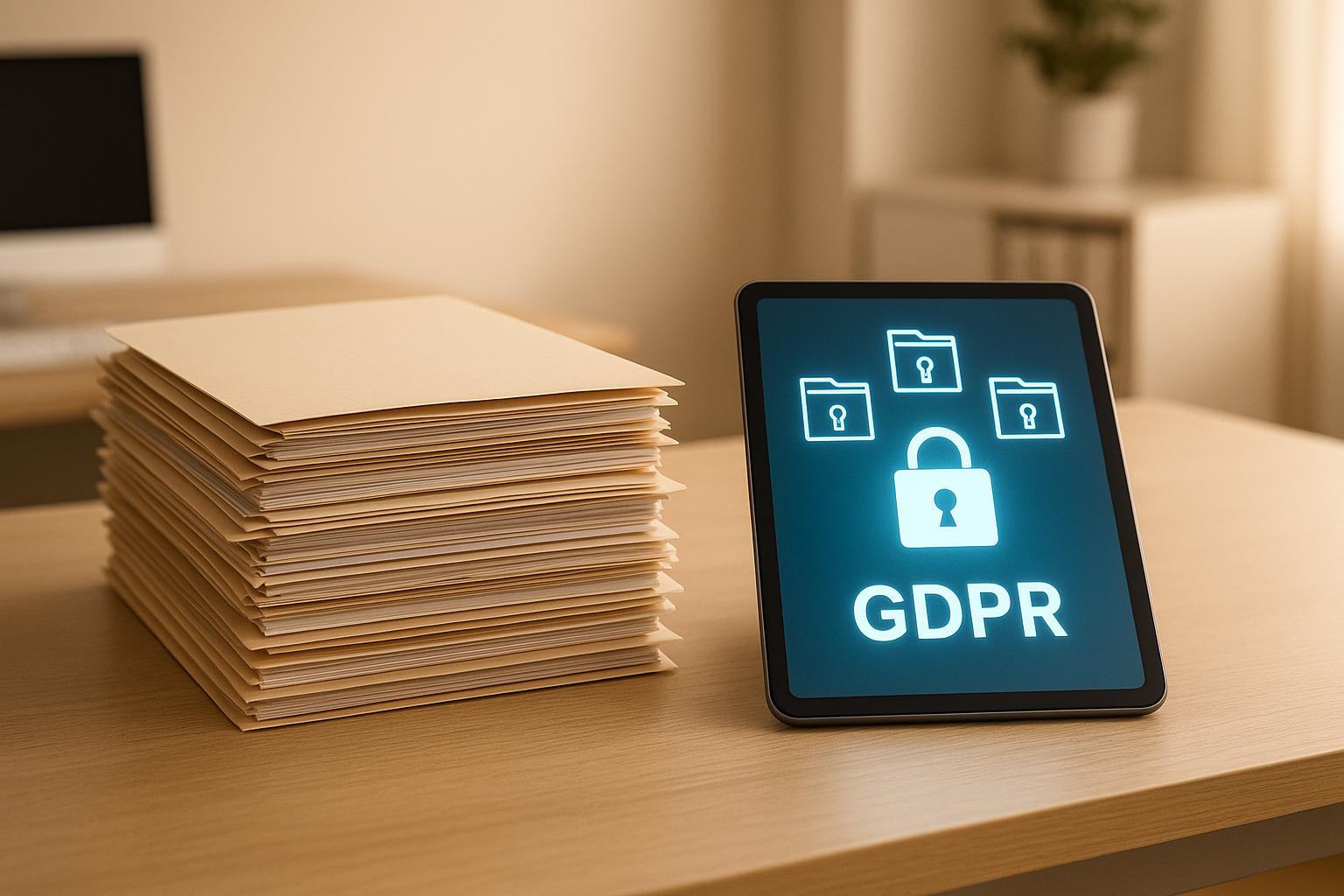Paper vs Digital Records: GDPR Compliance
Explore the compliance differences between paper and digital records under GDPR, highlighting efficiency, security, and practical benefits for therapy practices.

Managing client records? Here's the key takeaway: Both paper and digital systems can comply with GDPR, but digital records offer more efficient, secure, and scalable solutions. Paper records require strict physical safeguards and manual processes, while digital systems automate security, retention, and access management.
Key Points:
- GDPR applies equally to paper and digital records, covering session notes, treatment plans, and sensitive health data.
- Paper records demand locked storage, manual audits, and secure shredding for disposal.
- Digital systems use encryption, automated backups, and instant data retrieval, simplifying compliance.
- Audit trails are easier to maintain with digital platforms, reducing the risk of errors.
- Cost comparison: Paper may seem cheaper initially but incurs ongoing storage and administrative expenses. Digital systems like Konfidens start at £19/month (excl. VAT) for solo practitioners.
Quick Comparison:
| Aspect | Paper Records | Digital Records |
|---|---|---|
| Security | Locked cabinets, physical risks | Encryption, automated backups |
| Access Management | Key-based, manual logs | Granular permissions, auto-logging |
| Retention | Manual tracking, shredding | Automated deletion policies |
| Cost | Ongoing storage/admin costs | Subscription-based, scalable |
| Efficiency | Manual and time-consuming | Instant search and retrieval |
Conclusion: While paper records can meet GDPR standards, digital systems save time, reduce errors, and provide stronger security. For therapy practices looking to simplify compliance and operations, digital records are the better choice.
GDPR Requirements for Client Records
If you run a therapy practice in the UK, understanding your obligations under GDPR is non-negotiable. Whether you store client information on paper or digitally, the UK GDPR, supported by the Data Protection Act 2018, lays out clear rules on how personal data must be handled, secured, and managed. Ignoring these legal requirements can result in hefty penalties. Let’s break down what counts as personal data and the key GDPR rules around security and retention.
What Counts as Personal Data Under GDPR
Personal data includes any information that can identify an individual. For therapy practices, this means session notes, treatment plans, appointment records, and even therapy recordings. Some information, like health records, mental health details, or psychological assessments, falls under special category data. This type of data requires additional safeguards and usually demands explicit consent or another lawful basis for processing.
Under GDPR’s data minimisation principle, you’re expected to collect and store only the information necessary for your therapeutic work. Data collection must always have a clear, lawful purpose.
Another key requirement is establishing a lawful basis for processing data. Many therapy practices depend on explicit client consent or the lawful interest of providing healthcare services. Make sure to document your lawful basis, as it determines how you manage client rights - whether it’s granting access to records, correcting inaccuracies, or deleting data upon request.
Let’s now look at the rules for securing and retaining client records.
Security, Access, and Record Retention Rules
Whether your records are on paper or stored digitally, GDPR applies equally. The regulation requires you to put in place both technical and organisational measures to protect personal data from risks like unauthorised access, loss, or cyberattacks. While GDPR doesn’t dictate specific security methods, it does require you to assess risks and adopt safeguards that are appropriate for your situation.
Set up and document strict access controls, ensuring only authorised staff can access client records. Regularly review permissions, especially when new team members or external support staff gain access to your systems.
When it comes to retaining records, GDPR doesn’t specify exact timeframes for therapy-related data. You’ll need to balance legal obligations, professional guidelines, and the principle of not keeping data longer than necessary. Once records are no longer needed, dispose of them securely - shred paper files or use secure digital deletion methods.
If a data breach occurs, you may need to report it to the Information Commissioner's Office (ICO) within 72 hours of discovery. If the breach poses a high risk to clients’ rights and freedoms, you must also inform the affected individuals.
Finally, the accountability principle requires you to prove your compliance. This means keeping detailed records of your data processing activities, conducting regular risk assessments, and documenting the measures you’ve taken to protect client information.
Paper Records: GDPR Compliance and Practical Considerations
Under GDPR’s strict data protection framework, managing paper records requires careful attention and precise processes. Despite the growing reliance on digital systems, paper records remain a staple in many therapy practices, with 21% of businesses worldwide still using manual forms [3]. Importantly, GDPR treats paper documents with the same level of scrutiny as electronic data [2]. Below, we’ll explore practical steps to ensure paper records align with GDPR requirements.
How to Make Paper Records GDPR Compliant
Securing physical documents is a top priority. Client records should be stored in locked filing cabinets or secure rooms with limited access, and a clean desk policy should be enforced to prevent unauthorised exposure of sensitive information [2].
Access to these records must be restricted to authorised personnel, and detailed logs should be maintained to create a GDPR-compliant audit trail [2]. Training staff is equally critical - employees need to know how to handle personal data responsibly, including limiting unnecessary printing and securely disposing of documents [2].
Retention schedules for paper records should be monitored manually. When records are no longer needed, they must be securely destroyed using certified shredding services or high-security shredders [2]. Martin Fiddler, Information Security & Compliance Manager at Restore, emphasises the importance of this step:
"Creating an accurate list of the content of your archive boxes so you can identify where personal data is stored is the first step to GDPR."
Conducting a thorough audit of all stored paper files - including those in temporary or off-site locations - is essential to ensure full compliance.
Problems with Paper Records
Even with stringent measures, paper records come with inherent challenges. They are vulnerable to theft and physical risks such as fire or flooding [1].
Responding to data subject requests is especially cumbersome with paper-based systems. Manually searching through files, photocopying the necessary documents, and tracking instances of personal data is not only time-consuming but prone to mistakes. Additionally, maintaining accurate audit trails is nearly impossible, complicating matters during regulatory inspections.
The administrative burden is another major drawback. A staggering 96% of customers are willing to switch providers after a poor experience [3], and delays in fulfilling data requests can damage client trust. Paul Moonan, Managing Director at Restore, highlights this risk:
"If you can't be sure that all retention periods are being correctly controlled and complied with, this could easily lead to a GDPR breach."
The financial risks are substantial. Non-compliance could result in fines as high as £17 million or 4% of a company’s turnover [3][1], far exceeding the estimated £4.6 million cost of compliance. Moreover, paper records often clash with GDPR’s principle of data minimisation; the temptation to hold onto documents "just in case" can lead to excessive retention, unlike automated systems that ensure timely deletion.
Digital Records: GDPR Compliance and Practical Benefits
Digital record systems are a powerful tool for meeting GDPR requirements, combining automation with advanced security measures. Unlike traditional paper records, digital systems offer comprehensive solutions that not only ensure compliance but also streamline operations.
Digital Features That Support GDPR Compliance
Digital record systems are designed with GDPR in mind, leveraging automation and security to meet its demands. Encryption and secure storage are key features, protecting data both during transfer and while stored. Even in the unlikely event of a breach, encrypted data remains unreadable, offering a level of security that paper records simply cannot match.
Access controls further reinforce security, allowing practices to set specific permissions for who can view, edit, or delete records. Every interaction with client data is logged, including timestamps, user details, and actions, creating the detailed audit trails required under GDPR.
Automated retention and deletion policies remove the risk of human error, ensuring that data is deleted once it’s no longer needed. This aligns with GDPR’s data minimisation principle, which mandates that organisations only retain data for as long as necessary.
When clients exercise their rights under GDPR - such as requesting access to, or the deletion of, their data - digital search capabilities make the process quick and efficient. Instead of manually searching through physical files, digital systems can locate all relevant data instantly, saving both time and effort.
Why Digital Records Work Better in Practice
Beyond compliance, digital records bring a host of practical advantages. Instant data retrieval is a standout benefit, enabling practices to respond to subject access requests in hours rather than days. This not only ensures compliance but also strengthens client trust by demonstrating a commitment to transparency and efficiency.
Backup and disaster recovery features offer peace of mind. Digital systems automatically back up data to secure, distributed locations, protecting against risks like fire, flooding, or theft - scenarios that could irreparably harm paper-based systems. This redundancy ensures continuity, no matter the circumstances.
Integration capabilities allow digital systems to work seamlessly with other tools. Take Konfidens, for example - a platform that combines secure session notes with scheduling, video calls, and payment processing, all within a GDPR-compliant environment. This eliminates the hassle of juggling multiple systems, simplifying compliance and improving efficiency.
Additional features, like automated SMS reminders and recurring appointments, operate securely alongside client records. For UK therapists, this means managing all aspects of their practice while maintaining GDPR standards.
Cost efficiency is another major advantage. While the upfront investment in digital systems may seem high, the long-term savings in reduced administrative work, storage costs, and compliance management often outweigh the initial expense. Minimising manual processes also lowers the risk of costly GDPR breaches and fines.
Finally, scalability ensures that digital systems can grow with your practice. Whether you’re taking on more clients or expanding your team, digital platforms can handle the increased workload without the physical limitations of paper records.
Next, explore our comparison of paper and digital records to see how they stack up.
sbb-itb-0b4edca
Paper vs Digital Records: Side-by-Side Comparison
When comparing paper and digital records for GDPR compliance, the differences become striking when viewed side by side. Each method carries unique implications for security, efficiency, and adherence to regulations, all of which can significantly shape how your practice operates. This breakdown builds on earlier discussions about the strengths and limitations of each system.
Let’s start with security measures. Paper records depend on physical safeguards like locked cabinets, restricted access to rooms, and manual handling procedures. While these can be effective, they’re vulnerable to risks such as fire, flooding, or simple human error. On the other hand, digital systems employ advanced measures like encryption, automated backups, and secure cloud storage, offering round-the-clock protection.
Access control is another area where the two systems differ fundamentally. Paper records rely on physical key management, which can be cumbersome and hard to monitor. Digital systems, however, provide precise access permissions and automatically log every action, ensuring better oversight.
The audit trail capabilities further highlight the divide. Paper-based systems require manual logging, which is time-consuming and prone to errors. Digital platforms, by contrast, automatically track every activity, creating a comprehensive and reliable audit trail.
When it comes to fulfilling data subject rights under GDPR, the operational differences are stark. Handling a subject access request with paper records involves manually searching through files, photocopying documents, and delivering them physically - a process that can take days. Digital systems, however, enable instant data retrieval and secure delivery, often completing the task within hours.
Here’s a quick comparison of the two approaches:
Comparison Table: Paper vs Digital Records
| Aspect | Paper Records | Digital Records |
|---|---|---|
| Security | Physical locks, restricted access, vulnerable to damage | Encryption, automated backups, multi-layered security |
| Access Control | Key-based, hard to monitor | Granular permissions, real-time access logging |
| Audit Trails | Manual logging, prone to gaps | Automatic, comprehensive tracking |
| Data Retrieval | Manual, time-intensive | Instant search and retrieval |
| Backup Protection | Photocopying and off-site storage | Automated, distributed backups |
| Subject Access Requests | Days to weeks, manual compilation | Hours, automated data compilation |
| Retention Management | Manual tracking and physical destruction | Automated deletion policies |
| Storage Costs | Requires physical space, filing systems, and expansion | Subscription-based, scalable without physical limits |
| Disaster Recovery | High risk of loss, expensive recovery | Immediate restoration from secure backups |
| Integration | Standalone, manual coordination | Seamless integration with scheduling, payments, and communications |
Retention policy management is another area where digital systems shine. Paper records require manual tracking and physical shredding, leaving room for errors. In comparison, digital platforms like Konfidens automate retention policies, ensuring timely and error-free deletion of outdated records.
Cost considerations reveal an interesting dynamic. While paper systems might seem cheaper upfront, they come with ongoing expenses for physical storage, filing systems, and increased administrative work. Digital platforms, such as Konfidens, offer predictable pricing - £19 per month (excluding VAT) for solo practitioners - without additional costs as your record volume grows.
Finally, scalability is a critical factor for long-term planning. Expanding a paper-based system means investing in more physical space, filing equipment, and administrative time. In contrast, digital platforms grow effortlessly, handling increased client loads without requiring extra infrastructure or storage.
Digital systems also offer unmatched integration benefits. Many platforms combine secure record-keeping with scheduling, payment processing, and client communication, creating a unified environment for managing personal data. This not only simplifies GDPR compliance but also reduces the complexity of juggling multiple systems to meet regulatory requirements.
Conclusion
Switching to digital records can significantly improve GDPR compliance for therapy practices in the UK. While paper-based systems might technically meet the regulatory requirements, they demand more manual labour, are prone to errors, and struggle to align with the expectations of modern data protection standards.
Digital records provide features like automated audit trails, quick data access, and advanced security measures. For instance, when a client requests their data under GDPR, a digital system can handle the request in hours instead of the days or weeks that paper systems might take. These advantages clearly set digital records apart from their paper counterparts.
Although paper systems may seem cheaper at first, they come with ongoing costs for storage, equipment, and administrative tasks. On the other hand, digital platforms such as Konfidens offer predictable pricing. Their plans start free for up to three clients, with solo practitioners paying £19 per month (excluding VAT) for additional features - eliminating hidden expenses.
Paper records also face risks like fire, flooding, theft, and misfiling, whereas digital systems safeguard data with encryption and automatic backups. Moreover, digital records streamline operations by integrating with practice management tools, removing the hassle of manual tracking. They also scale easily, avoiding the need for extra physical storage or administrative resources.
While paper records can still be legally compliant if managed correctly, they pose higher risks and require more effort to maintain. Digital systems, by contrast, provide stronger security for client data and simplify operations, making them the smarter option for therapy practices aiming for reliable GDPR compliance. Beyond meeting legal standards, digital records enhance efficiency and security, offering a forward-thinking solution for modern practices.
FAQs
How can therapy practices stay GDPR-compliant when managing paper records?
To comply with GDPR when handling paper records, therapy practices need to prioritise secure storage. This can mean using locked filing cabinets or keeping records in rooms with restricted access, ensuring only authorised staff can reach them. It's also crucial to establish clear protocols for safely destroying records once their retention period is over. Regularly reviewing and updating data retention policies helps prevent holding onto records longer than necessary.
Staff should receive thorough training on maintaining confidentiality and securely managing sensitive information. Keeping paper files organised and easy to trace reduces the risk of unauthorised access and helps meet GDPR standards. Taking a proactive stance on security and data management is essential for safeguarding client information effectively.
What are the benefits of using digital records instead of paper records for GDPR compliance?
Switching to digital records brings clear benefits when it comes to GDPR compliance in the UK. With digital systems, sensitive data can be securely stored, accessed, and managed using tools like encryption, controlled access permissions, and automated backups. These features significantly lower the chances of unauthorised access or data breaches.
On top of that, digital records make it much easier to meet GDPR requirements. For example, they streamline tasks like keeping detailed records of data processing activities and ensuring secure storage. Unlike paper records, which can be cumbersome to organise and protect, digital systems offer a more efficient and scalable way to handle client information while staying within the boundaries of legal obligations.
What should I do if there’s a data breach involving client records?
If a data breach happens - whether involving paper or digital records - swift action is crucial. Begin by containing the situation and evaluating its impact to understand the potential risks to individuals' rights and freedoms. If there’s a likely risk, you’re required to report the breach to the ICO within 72 hours of becoming aware of it. This report should include details about what occurred and the measures taken to address the issue.
For breaches that pose a high risk to individuals' rights, you must also notify those affected without delay. Thorough documentation is key - record the cause of the breach, its impact, and the corrective actions taken. This not only helps in managing the situation but also demonstrates compliance with GDPR regulations.




